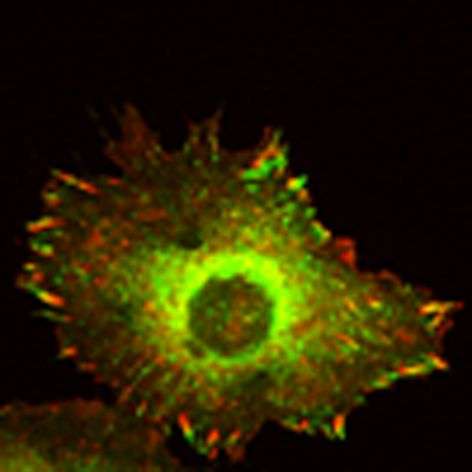Cadherin-11 plays role in cell migration

Cadherins are part of the protein family of adhesion molecules. Just like mortar between the bricks in a wall, they ensure that cells stay together, preventing them from breaking away and migrating from a group of cells. Especially in tumor cells, however, cadherin-11 behaves in exactly the opposite way – it triggers the migration of cells. Experts from KIT and the University of Massachusetts explain this mechanism in the Nature Communications journal.
"The reason why cadherin-11 is so exciting for us is because it can be detected in up-regulated form in prostate and breast tumors, as well as in arthritis," said Jubin Kashef, a specialist in cell and developmental biology. KIT scientists explored the question of why particularly this cadherin causes tumor cells to migrate. They investigated the action of cadherin-11 in neural crest cells, in other words early embryonic cells with high migration characteristics. In early embryonic cell development there are surprising similarities to tumors, turning embryonic cells into an interesting model system for examining tumor development. The behavior of embryonic cells is guided by the same principles that are used by tumors, for example a change in cell shape and the inclination to migrate and intrude into foreign environments.
Scientists have now learned that cadherin-11 can not only bind the cells, but also form a bridge to the extracellular area. In this case it combines with the syndecan-4 protein. This is crucial because syndecan-4 is a receptor of fibronectin, a stubstrate protein, on which cell groups can wander through the body like on a road. On this "fibronectin carpet", cadherin-11 provides the cells with the necessary hold for migration, but only in connection with syndecan-4. "For the first time we have been able to provide proof of this form of cell substrate adhesion with our research," said Kashef.
With the help of embryonic cells of African clawed frogs and cell cultures, the zoologist and his fellow researchers have demonstrated that cell migration will be interrupted if both proteins are neutralized. "If you understand the mechanism you can disable it," said KIT's Clemens Franz, a specialist in nanostructures. This not only opens up new potential for a clearer biological understanding of the metastasis of tumors, but also provides the option of developing peptides or antibodies, which prevent the migration of cells responsible for the metastasis of tumor cells and highly inflammatory diseases such as arthritis.
More information: Rahul P. Langhe et al. Cadherin-11 localizes to focal adhesions and promotes cell–substrate adhesion, Nature Communications (2016). DOI: 10.1038/ncomms10909
Journal information: Nature Communications
Provided by Karlsruhe Institute of Technology















